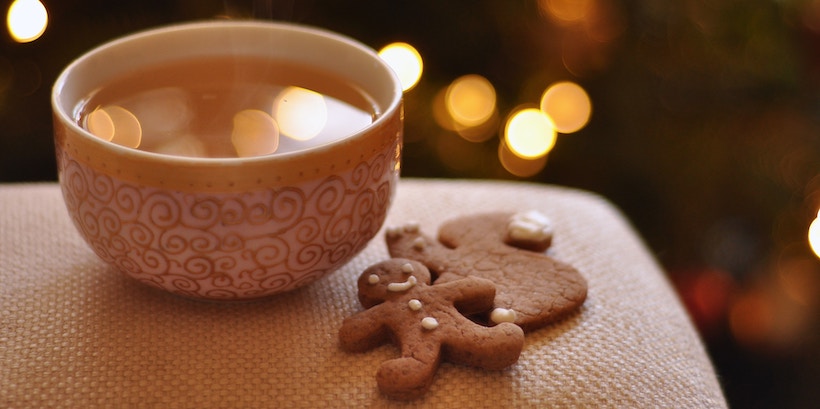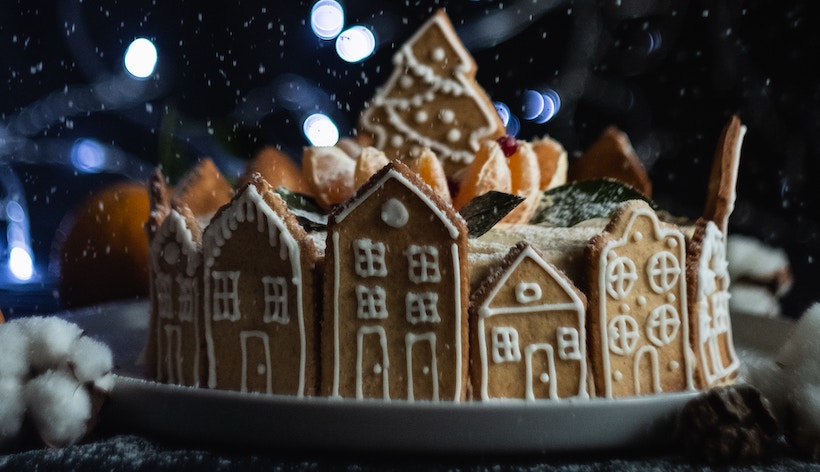Gingerbread has become a big part of our Christmas tradition. Every year, my daughters can't wait to build and decorate (their own, as it turns out) gingerbread houses.
It feels like gingerbread, as a winter tradition, has been around forever. Of course, that isn't the case – but it does turn out ginger has an extremely long, popular history as a tradeable spice.
Come with me as I investigate the history of gingerbread. We'll cover ginger's past, from its usage in China and the Middle East then through trade with Ancient Greece – and finally, to the cookies you decorate with your kids.

Starting at the root (pun intended) – ginger is a slightly sweet, slightly spicy spice processed from ginger root. While European and American cuisines often use ginger as a shorthand for the seasoning (as I'm doing here), notably, the root is used in a sliced yet natural state on its own in many dishes worldwide.
When the ginger root is dried and powdered, you get the spice form of ginger that stars in this post today. This is the form you'll most often find in gingerbread, ginger ale, cakes, crackers, cookies, tea, and ginger beer.
In Chinese, Indian, and other Southeast Asia and Middle Eastern cuisine, ginger is more often used in its natural, root form. Notably, ginger finds its way into dishes based on meats such as beef, chicken, pork, and fish. Ginger is a critical ingredient in Indian Curry and chutney – and a standard component in a variety of dishes from various regions in China.
Ginger is also used worldwide for its purported medicinal benefits. Ginger has proven benefits with gastrointestinal issues such as nausea and indigestion and is also well-known to help with dizziness and motion sickness.
Ginger is most likely native to Southeastern Asia, although nowadays it is cultivated around the globe.
There is good evidence ginger was a very early trade good between Ancient Greece and Rome (and possibly Egypt) and the Southeastern Asian islands where gingerroot was cultivated. Ginger is listed as a taxable good from as early as the 2nd century in Greece.
Ginger (and a few other spices) became such a precious commodity that, for some time, it was priced much too high for most of the population to afford. Once the prices leveled out and became affordable, there was an increase in its usage by all levels of society.

The exact year ginger made its way to Northern and Western Europe is, alas, lost to history – but many scholars believe it made its way into Western Europe around the first Crusade (1095-1099).
A competing thread instead traces it back 100 years earlier to Archbishop Gregory Markar – later, Saint Gregory of Nicopolis – who brought it with him as he left Turkey for Gâtinais, France. Gregory is said to have served visitors a cake made of spices "in the fashion of his far away homeland in Armenia."
Whichever thread you believe, ginger (and gingerbread's) popularity only grew over the ensuing years (fine, centuries). Lebkuchen – a related spiced cookie popular in Germany around Christmas – was being baked in barkeries in the 13th and 14th centuries. By the 16th century, monasteries and bakeries around Europe were baking tons of gingerbread and ginger snaps.
So, although we can't be sure when ginger in bread-or-biscuit-form first rose to prominence, ginger was circulating in Europe by the 11th century, and we have evidence for gingerbread's popularity in the 13th and 14th centuries.
Ginger is grown in India, Nigeria, China, Indonesia, Nepal, Nigeria, and Thailand – but increasingly, all around the world. It is a key crop with millions of pounds of the root or spice form traded each year.
You can grow it all around the world now (especially with a greenhouse or artificial climate assist), but outdoors ginger likes hot or warm weather with a bit of humidity.
Here's a look at growing your own ginger... if you want to get in on the ginger-game:
The word gingerbread initially referred to the small candied confection still popular in Great Britain. Gingerbread as a baked good didn't really originate in Northern Europe, though - Greece likely had a recipe as early as 2400 BCE.
In the 13th century and beyond in Europe – as our spiced hero became more popular and spread across the continent – gingerbread started its association with the soft cakes and cookies famous around the world even today. And it's true: "gingerbread" is an all-encompassing term describing a myriad of different styles of baked breads, biscuits, and cookies using ginger as their central ingredient.
Ginger made its way to Northern and Western Europe either during the Crusades or via Saint Gregory of Nicopolis. It percolated through bakeries and monasteries in Europe, and eventually, there were even Gingerbread Guilds – separate from other Baking Guilds in Europe!
In Medieval Europe, spices were quite expensive for centuries – but over time, established trade routes with the East Indies drove down spice costs. Roughly during the 15th and 16th centuries, ginger finally became affordable enough for commoners to enjoy.
Medieval recipes for gingerbread were substantially different from what we associate with modern gingerbread. Recipes became protected around the time the Gingerbread Guilds began to form all over western Europe.
In Europe, gingerbread cookies and cakes sold at fairs picked up the shorthand fairings. Evidence dates back to the 12th century of ginger-spiced fairings sold as trinkets, souvenirs, and good luck charms – but also as edible treats.
And treats isn't an understatement – fairings popularity overlapped with when spices were still quite expensive.
Gingerbread at fairs and festivals were a rare, treasured favorite during the Medieval ages. Fairings at these – ahem – fairs were a demonstration of art and cooking skills. Since ginger-spiced bread and cookies were so popular, some cities even started to throw dedicated gingerbread festivals. Ladies gifted their favorite knight with a piece of gingerbread for luck before they took part in a tournament. Other old wives' tales held the superstition that if a single woman were superstitious, she would eat a 'gingerbread husband' to improve her chances of finding a real husband.
Gingerbread Fairs were most common in Germany, France, Poland, Russia, and Hungary.
Wooden molds were the most common way to shape gingerbread treats during the Medieval period. More dense recipes were formed into cookies and biscuits, while thinner dough was made into cakes and crepes.

So here's an interesting aside, the Gingerbread Man shape and tradition we all know and love runs straight through British royalty.
In The Surprising History of Gingerbread Men, it's noted that Queen Elizabeth I – Queen of England from 1533-1603 – invented the Gingerbread man. Her anthropomorphic take on ginger cookies was presented to guests who visited – in their likenesses. The Queen even had a master Gingerbread maker dedicated to the task – she became known for the elaborate desserts served at Buckingham Palace.
And of course, the Royal voice is a loud one; as tales of the Queen's edible gifts spread, human-shaped gingerbread cookies gained in popularity across the continent.
Gingerbread has been a notable part of American culture for over 200 years.
Over time, gingerbread recipes have evolved into elaborate cakes, cookies, and biscuits, mostly associated with the Christmas holiday season.
Gingerbread has been present in America since the Colonies. Most likely, gingerbread first made its way stateside due to early German immigrants who took their ginger-heavy variants on lebkuchen to America. Certainly, gingerbread was popular almost from America's very beginnings – in the German communities, and across the fledgling colonies.
One of the more famous early recipes came from none other than the mother of George Washington, America's first President (and hero of the Revolutionary War).
Mary Ball Washington's 1784 recipe called for cookies cut in the shapes of soldiers. Following the end of the war, she began to make the cakes in the shape of an Eagle to symbolize the United States. The cakes were a popular treat for early voters – and an interesting footnote on a volatile period.
I don't have Mary Washington's recipe handy – I couldn't find it in my research. However, Amelia Simmons' American Cookery recipe from the same era (1796) is available, if you'd like to try some 18th century gingerbread:

From American Cookery by Amelia Simmons (1796)
One table spoon of cinnamon, some coriander or allspice, put to four tea spoons pearl ash, dissolved in half pint water, four pound flour, one quart molasses, four ounces butter**, knead well 'till stiff, the more the better, the lighter and whiter it will be; bake brisk fifteen minutes; don't scorch; before it is put in, wash it with whites and sugar beat together.
* if you aren't in possession of potash or "pearl ash" (Potassium Carbonate), substitute with 2 tbsp. baking soda
** Simmons notes: "if in summer rub in the butter, if in winter, warm the butter and molasses and pour to the spiced flour"
(Please let me know if you try it with pearl ash!)
As I mentioned, German immigrants most likely brought gingerbread over to the colonies. It was a staple of the early German Colonies found in Pennsylvania and Maryland. It then rose in popularity because molasses – a key ingredient in gingerbread – was cheaper to acquire than sugar.
It is believed that the earliest settlers of german lineage brought their family recipes and rituals with them to early America. Over time, those recipes were shared throughout the country – and coloring today's gingerbread houses and cookies.
In the beginning, the non-German communities tended to use ginger for medicinal purposes... not for crafting houses and people. Still, once gingerbread became common (especially during the holidays), other colonies embraced the tradition and started picking up on the gingerbread tradition.
Gingerbread has come a long way from those hard confections with which it was initially identified.
As time passed and ingredients changed, those hard confections evolved into everything from the dense cookies and light cakes you know today. Gingerbread remains an integral part of holiday traditions in many different cultures around the world.
There are thousands of different recipes for gingerbread floating around today, and I can't claim a standard. However, I do have some favorites (which line up with the most popular ones). Many of the most popular recipes rely on molasses, sugar, and careful assembly of dough.
Gingerbread can be either crispy in the form of a ginger snap or soft like the cookies we carefully cut out and decorate. Recipes can end up either light or dark brown owing mostly to the type of molasses (and how many boiling cycles) you choose.
If there's one area where many people agree on a gingerbread recipe – it's in gingerbread houses at Christmas. Okay, we're not in complete agreement – many countries stress building the walls, roof, and base from scratch, but in others (like the United States), prepackaged and prebaked gingerbread kits reign supreme. Either way, gingerbread houses as a central focus of a holiday display has become a tradition in many celebrating countries.
Gingerbread became associated with the Christmas Season due to the groundwork Germany laid in the 15th-16th century. Their stiff cookies and embrace of gingerbread houses – with exotic (especially at the time) spices and frosting to emulate snow – really kicked the holiday association into high gear.
It's logical that the spice – with its high prices at the time – would become associated with *a* special occasion; it's the properties of gingerbread and the associated decorations the pushed it towards Christmastime in Germany. In Germany, ginger cookies were cut into shapes, baked crispy, decorated, dipped in port wine, and hung on the Christmas tree. Accompanied by the aforementioned gingerbread houses festively assembled with candy embellishment, it was almost a guarantee the popularity would continue.

Hansel and Gretel is a famous fairy-tale, recounted by the Brothers Grimm in 1812. In it, Hansel and his young sister Gretel are abandoned by their parents during a famine then kidnapped by a woods-dwelling witch living in a gingerbread house.
Thankfully, they outsmart the witch and immolate her, and everyone lives happily ever after – Brothers Grimm indeed.
Hansel and Gretel is arguably the most famous of all the gingerbread-focused literature. But it's not the only material gingerbread one.
In 1875, an infamous article appeared in St. Nicholas Magazine called The Gingerbread Boy. In that short story, a living gingerbread cookie in boy-form spawned from a "lit-tle old wom-an" and proceeded to wreak mayhem over the countryside.
After riling up a pensioner, threshers, lawn-mowers, and various ungulates, he taunts a fox – and finally meets his true destiny: dinner.
As short stories, Hansel and Gretel and The Gingerbread Boy really put gingerbread on the popular culture map for modern culture. Of course, by that point, none other than Shakespeare had already written about it.
In Love's Labor Lost, the character Costard rips off this response:
"An I had but one penny in the world, thou shouldst have it to buy gingerbread."
(Not my first choice of purchase – but I can see the appeal.)

A key character in Hansel and Gretel is, well, the Gingerbread House owned by the witch. As the answer to the abandoned children's' plans, it appears at the perfect point in the fairy tale and ominously leads them into danger.
Now, the gingerbread house existed before Hansel and Gretel. However, it's impossible to extricate the massive explosion in the popularity of gingerbread houses from Hansel and Gretel's publication. Historians' best guess is that gingerbread houses grew in popularity with the fable, eventually leading us to today's holiday tradition.
Wherever and whenever it started, the gingerbread house has become a standard in Christmas decorations and celebrations. Every year, festivals around the world now cater to the art of the gingerbread house. Houses can be small and straightforward, or they may be complex enough to take up a lot of space – or even require a building permit.
Embellishments often include icing ("snow"), and as the decorations become more sophisticated, they may consist of candies, nuts, fruits, and other enhancements.
It isn't hard to picture the Hansel and Gretel house when you see some of the professional gingerbread house interpretations nowadays!
"Gingerbread" as you and I understand it is actually but one of many varieties all around the world. Gingerbread's well-deserved popularity has spawned dozens of unique twists on the basic recipe – with thousands (if not tens of thousands) of local variations on the methodology for local taste.
Here's but a few of the forms found around the world:

And there you have it – the next time you decorate a gingerbread house with your kids at the kitchen table, you're continuing a tradition centuries long. From ginger's dominance in the spice trade to its uncertain migration into Europe to its burst to popularity as a holiday tradition, you're continuing on a well-worn path of holiday cheer.
So whether you're making ginger snaps, ginger cookies, gingerbread men and women, gingerbread homes, or some other gingerbread-related structure – you're in good company.
Enjoy your project, and happy holidays!